Chagas Disease: A Deadly "Kiss"
Chagas disease, caused by Trypanosoma cruzi, is a serious parasitic infection often overlooked in non-endemic areas, with rising U.S. cases. Join us for this week's discussion on this topic!

If you work at a large academic medical center in a large urban area, it's possible you may get a fair share of parasitic infections including cryptosporidiosis, giardiasis, strongyloidiasis, and of course the occasional taeniasis (tape worm infection). Being in an urban area with high rates of immigration and travel increases the prevalence of parasitic infections. What may spark a lot of interest and curiosity, though, is if someone came in with a positive result for Chagas Disease (also known as American trypanosomiasis).
If you've never heard of Chagas before, don't worry, you're not alone. Plenty of healthcare professionals are also unaware of this parasitic infection as it's relatively rare outside of endemic areas. According to a recent article published this past May 2025 by Santanello et al., out of 79 respondents to a phone survey on Chagas awareness, 64% (51/79) were unfamiliar with the disease.1
Today we'll review the basics of Chagas, signs and symptoms, and how to treat this potentially life-threatening parasitic infection.
Trypanosoma cruzi
Background, Geographic Distribution, and Transmission
Named after Dr. Carlos Chagas, a Brazilian physician and researcher who first diagnosed the disease on April 14, 1909, Chagas has been estimated to affect more than 7 million people worldwide. It's currently endemic in 21 continental Latin American countries per the World Health Organization.2 Argentina, Bolivia, Brazil, and Mexico have the highest prevalence rates, accounting for approximately 70% of all estimated cases.3 In the United States specifically, it's estimated at least 280,000 individuals are affected by Chagas.4
Below is a map of the relative geographical distribution of Chagas including endemic regions and areas where it is present (non-endemic):
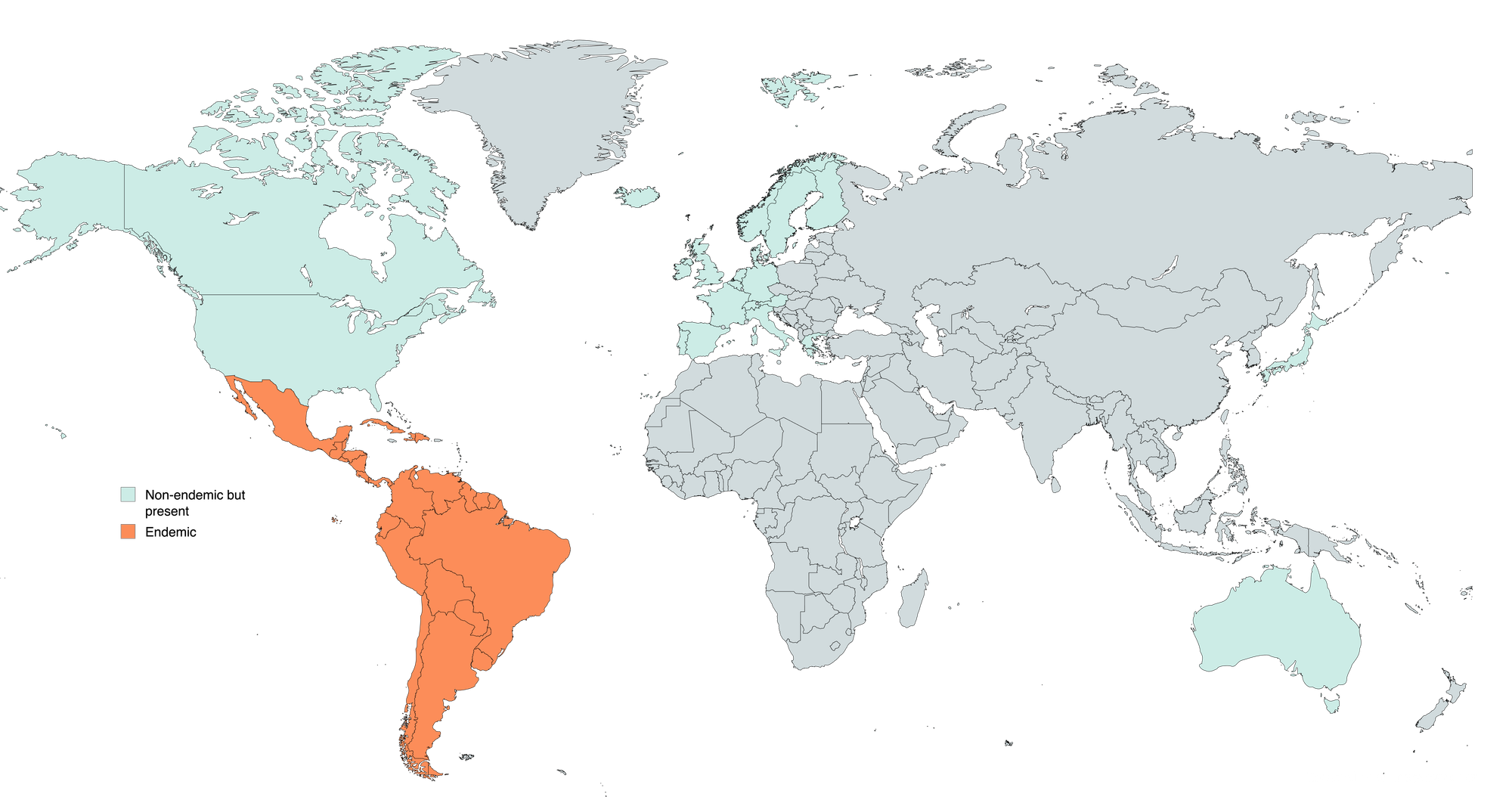
The causative pathogen is a protozoan parasite called Trypanosoma cruzi. Primary transmission occurs via Triatomine bug vectors (also known as the "Kissing bug"). Kissing bugs feed on blood throughout their life and are mostly nocturnal. Adults can range from1/2 to 1 inch long. They hatch from small eggs and go through five juvenile (nymphal) stages before they become adults. Some kinds of kissing bugs can live up to two years and typically live in the wall or roof cracks of homes and surrounding structures, such as chicken coops, pens, and warehouses, in rural or suburban areas.2,5

In places, like the U.S., where Chagas disease is present but not regularly spread by Triatomine bugs, it's important to recognize infection and prevent its spread through other modes including blood transfusion, organ transplantation, birth (mother to baby), laboratory exposure, and ingestion of uncooked foods contaminated with feces from infected kissing bugs.4
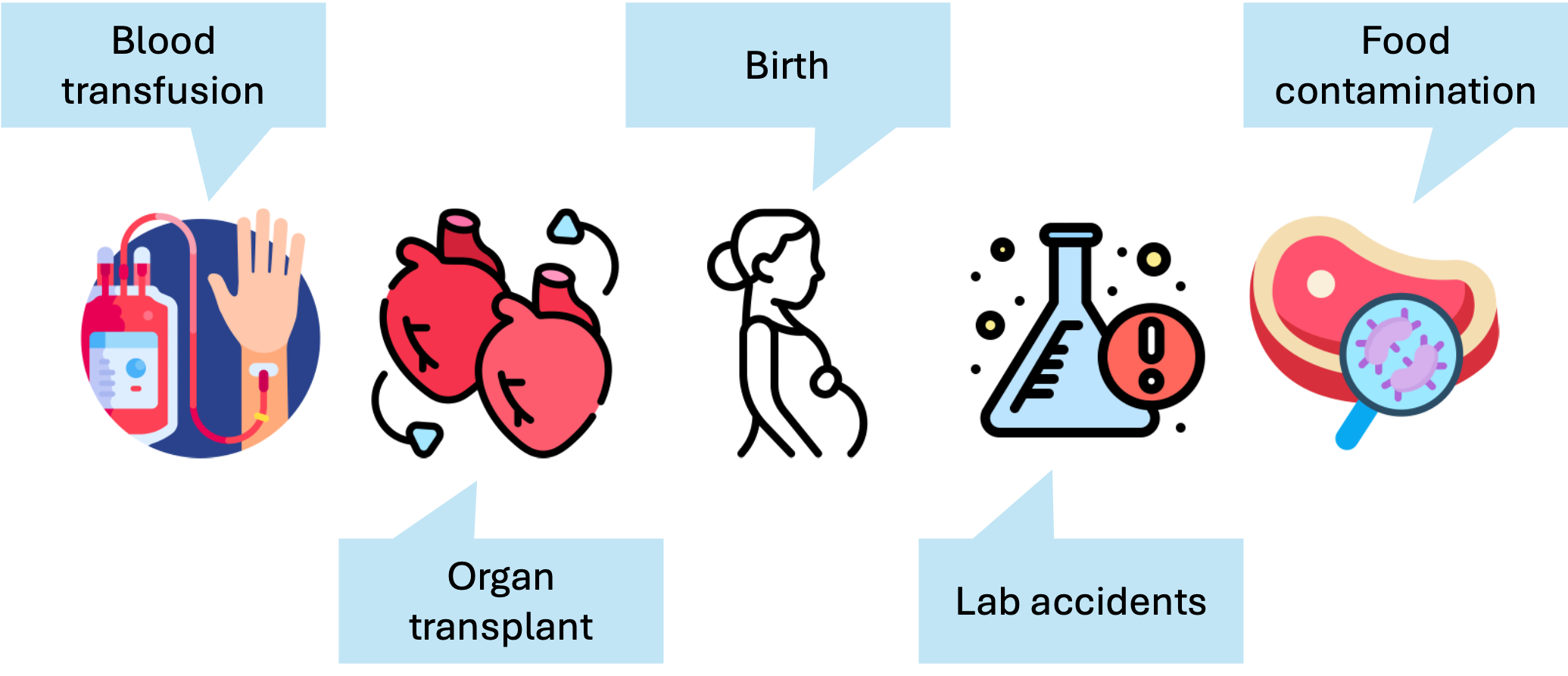
T. cruzi
Life Cycle
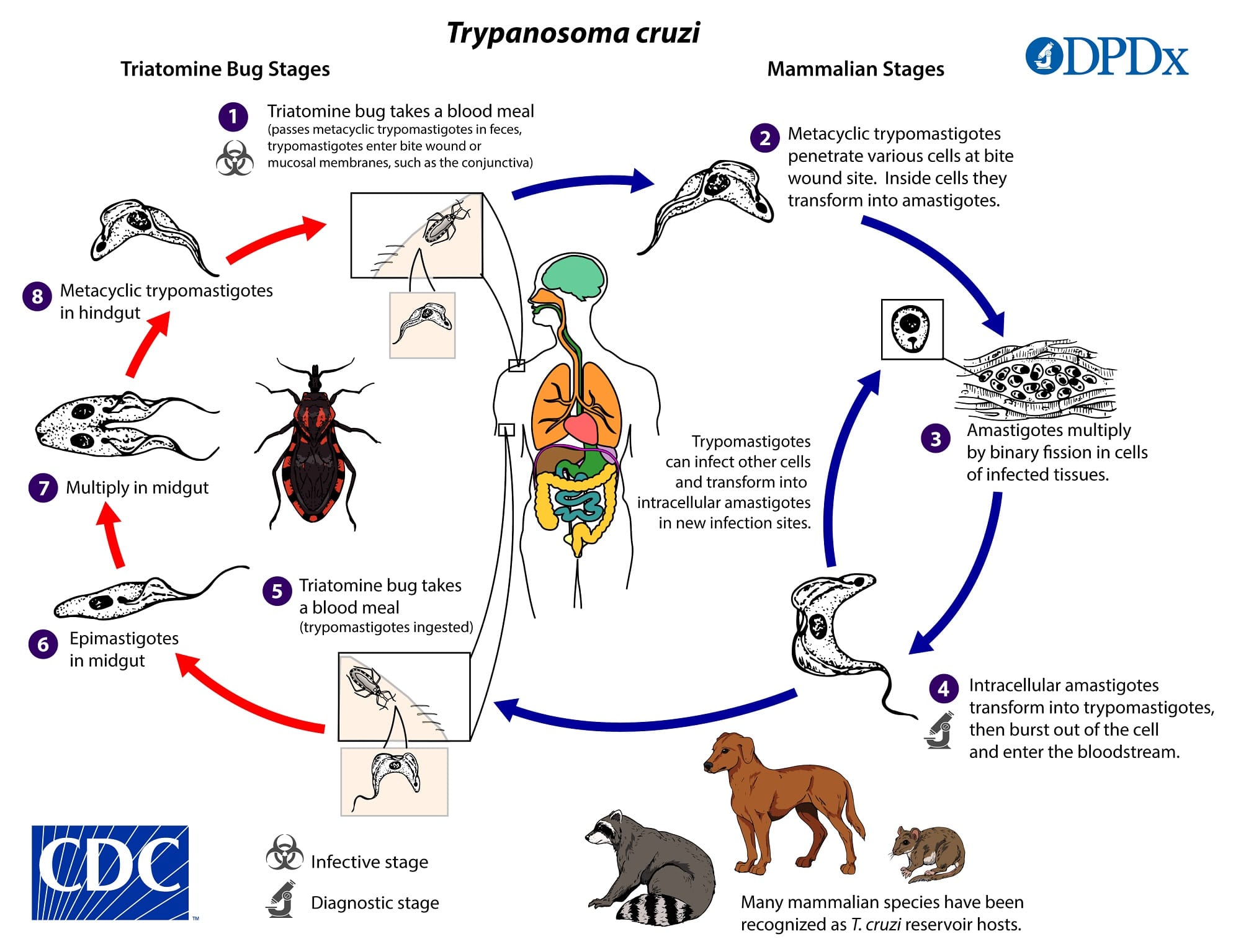
- An infected kissing bug bites a host (human or other mammals) and releases trypomastigotes in its feces near the site of the bite wound. Trypomastigotes enter the host through the bite wound or intact mucosal membranes, such as the conjunctiva.
- Inside the host, the trypomastigotes penetrate and invade cells near the site of inoculation, where they differentiate into intracellular amastigotes.
- Amastigotes multiply by binary fission within infected cells.
- After multiplying, amastigotes will differentiate back into trypomastigotes, and are then released into the circulation as bloodstream trypomastigotes.
- Through the blood, trypomastigotes can migrate to other areas of the body where they can once again penetrate and infect cells to continue the cycle of transforming into intracellular amastigotes and then again back into trypomastigotes.
- To jump from host to host, kissing bugs that feed on the blood of an already-infected host will ingest bloodstream trypomastigotes.
- While inside the kissing bug, trypomastigotes transform into epimastigotes.
- Epimastigotes multiply within the midgut of the kissing bug.
- The epimastigotes then differentiate into infective metacyclic trypomastigotes, where they are ready to infect the next host once the kissing bug bites again.
T. cruzi
Morphology
Trypanosoma cruzi are hemoflagellate protozoan parasites and have three main forms (as shown in the above life cycle):
- Amastigotes
- Epimastigotes
- Trypomastigotes
Amastigotes (only found within infected cells) are round, and the flagellum is not apparent.
Trypomastigotes (the infective form and the only form found in the blood) are long and slender, ranging from 12 - 30 µm under the microscope.6 They have an undulating membrane that helps with mobility along with the flagellum. A large kinetoplast (a mass of mitochondrial DNA) is located at the posterior end with a centrally-positioned nucleus.
A clever way that parasitologists identify and differentiate T. cruzi (apart from T. brucei, the other Trypanosoma species) under the microscope is by its shape and positioning. Many times, T. cruzi trypomastigotes can be found positioned in its characteristic "C" shape (T. cruzi has a "C" in it while T. brucei doesn't). T. brucei is generally longer and more squiggly.
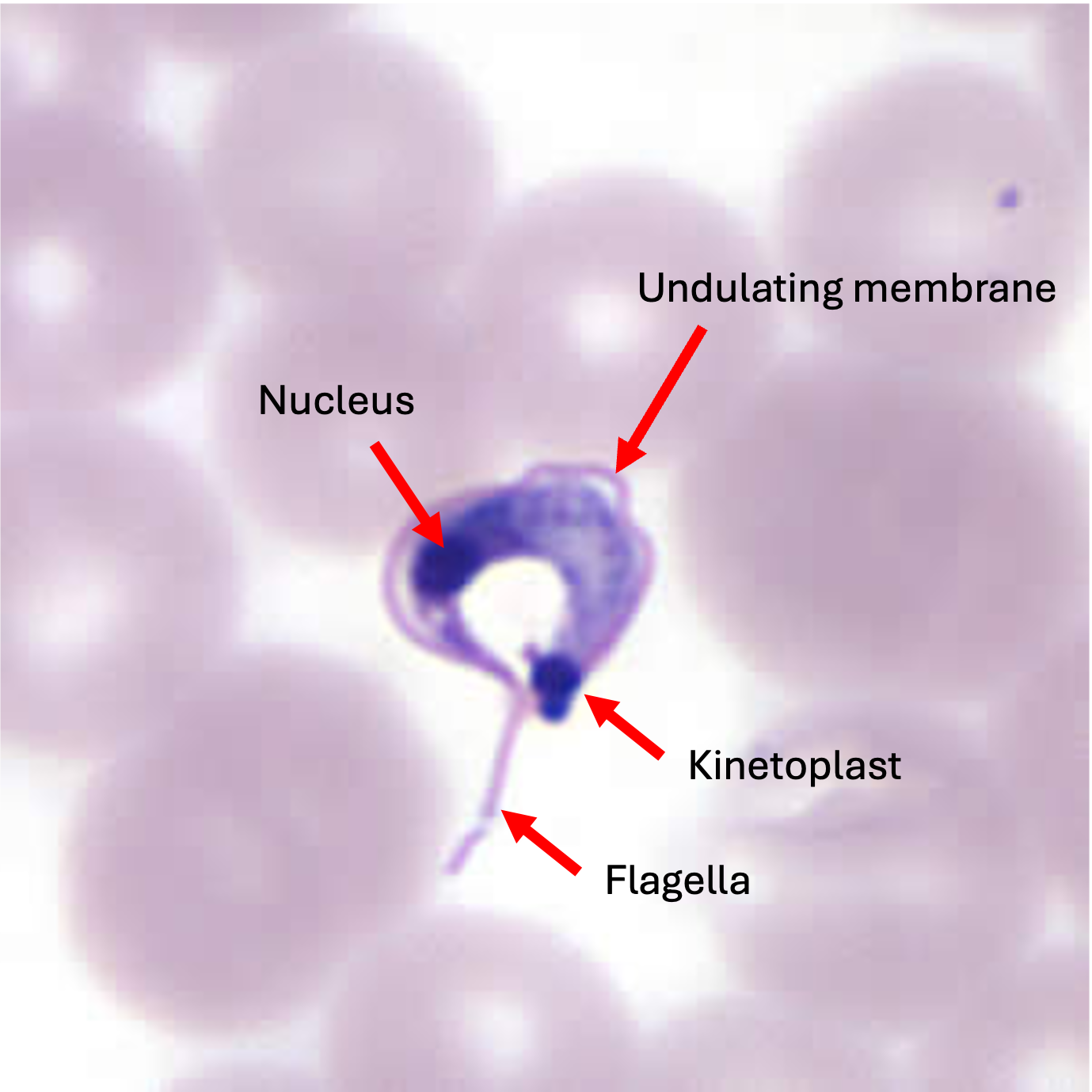
Epimastigotes resemble and are structurally similar to trypomastigotes. The main difference, however, is that the kinetoplast is located anterior to the nucleus.
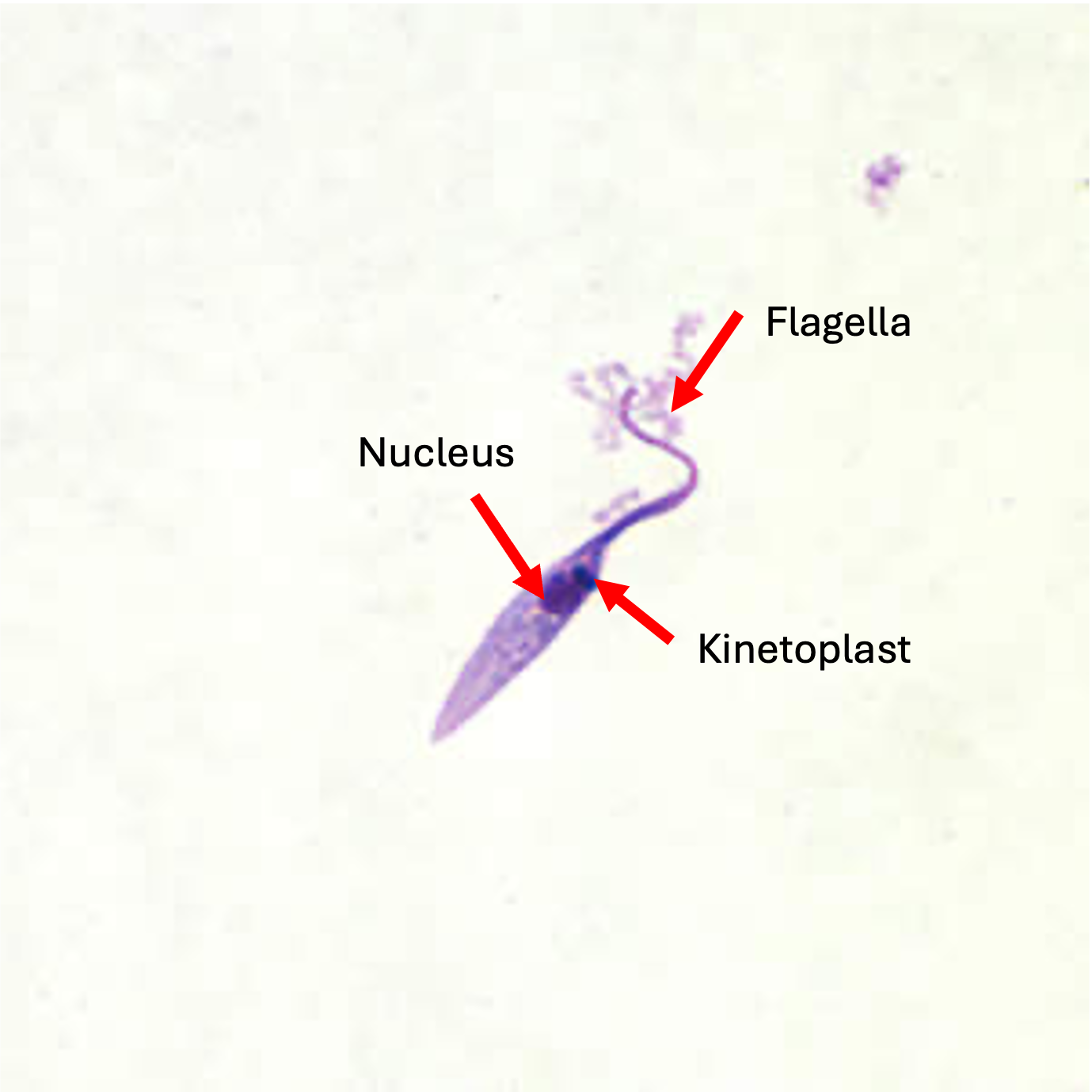
Chagas Signs & Symptoms
Chagas disease has two clinical forms/phases/presentations: acute and chronic. Many people (70- 80% of the infected) are asymptomatic all of their lives, while 20-30% of those infected evolve into the chronic phase, which includes symptoms that indicate damage to the tissue of the heart, digestive system and/or nervous system.7
Signs and symptoms for acute Chagas disease can be absent or mild and include the following:
- Signs of entry of the parasite
- Rash and inflammatory nodules (Chagoma)
- Swelling of periorbital soft tissue, typically on the side of the face where the bite occurred (Romaña's sign)
- While characteristic of Chagas, Romaña's sign is only visible in < 50% of infected individuals
- Fever
- Headache
- Nausea, diarrhea or vomiting
- Enlarged lymph glands
- Difficulty breathing
- Muscle, abdominal or chest pain

Signs and symptoms for chronic Chagas disease can include the following:
- About 30% of people will develop cardiac damage
- Cardiomyopathy
- Heart rhythm abnormalities
- Apical aneurysm.
- Sudden death or heart failure caused by progressive destruction of the heart muscle
- Less than 10% of patients will experience enlargement of the gastrointestinal tract and organs, and gastrointestinal motor disorders
- Enlargement of the esophagus
- Enlargement of the colon (megacolon)
- Disturbances of gastric emptying
- Colon and gallbladder motor disorders
Chagas Treatment & Management
It's important to note that current pharmacologic treatments are only effective during the acute phase of Chagas (about the first two months of infection). Once Chagas progresses to its chronic phase, treatment to eradicate the parasite may no longer work (BUT it may help to improve complications).
There are two main prescription medications that are FDA-approved (in pediatrics) for Chagas:
- Benznidazole (Rochagan, Radanil)
- Nifurtimox (Lampit)
Benznidazole is FDA-approved in ages 2 - 12 years and is commercially available at http://www.benznidazoletablets.com. Providers need to specifically request to obtain the medication for their patients in the setting of a positive result.

Benznidazole, a nitroimidazole, exhibits antimicrobial activity against all three stages (amastigote, epimastigote, trypomastigote) of T. cruzi. The mechanism of action includes inhibiting DNA, RNA, and protein synthesis.
Further information including dosing, side effects, and clinical pearls are listed below in the table:
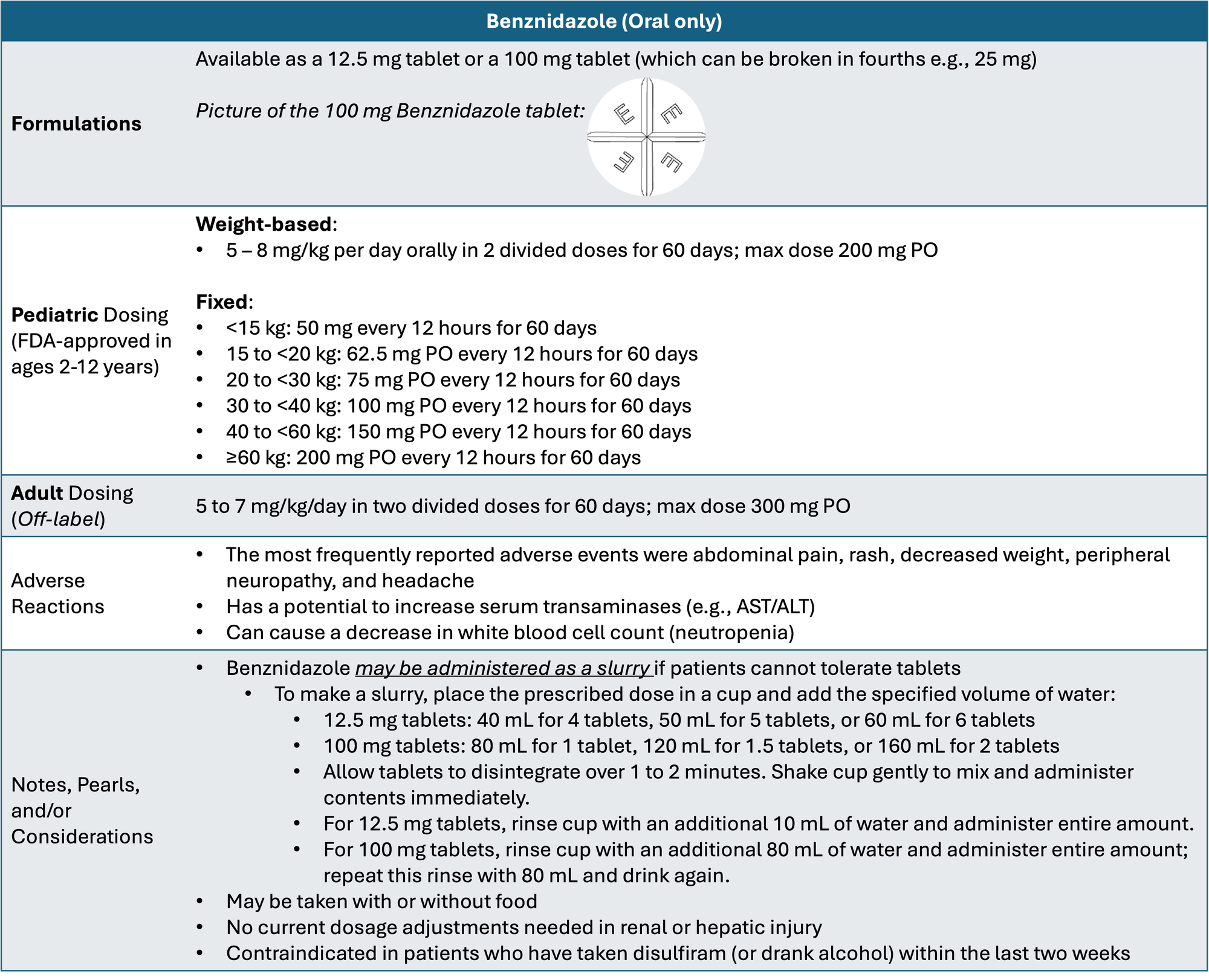
Nifurtimox is FDA-approved from birth to < 18 years and is commercially available for pharmacies to purchase from several drug wholesalers.

The mechanism of action of nifurtimox, a nitrofuran, is not well described. The current theory suggests that it undergoes metabolism/activation by type I (oxygen-insensitive) and type II (oxygen-sensitive) nitroreductases, leading to production of toxic intermediate metabolites and/or reactive oxygen species that induce DNA damage and cell death of both intracellular and extracellular forms of T. cruzi.
Further information including dosing, side effects, and clinical pearls are listed below in the table:
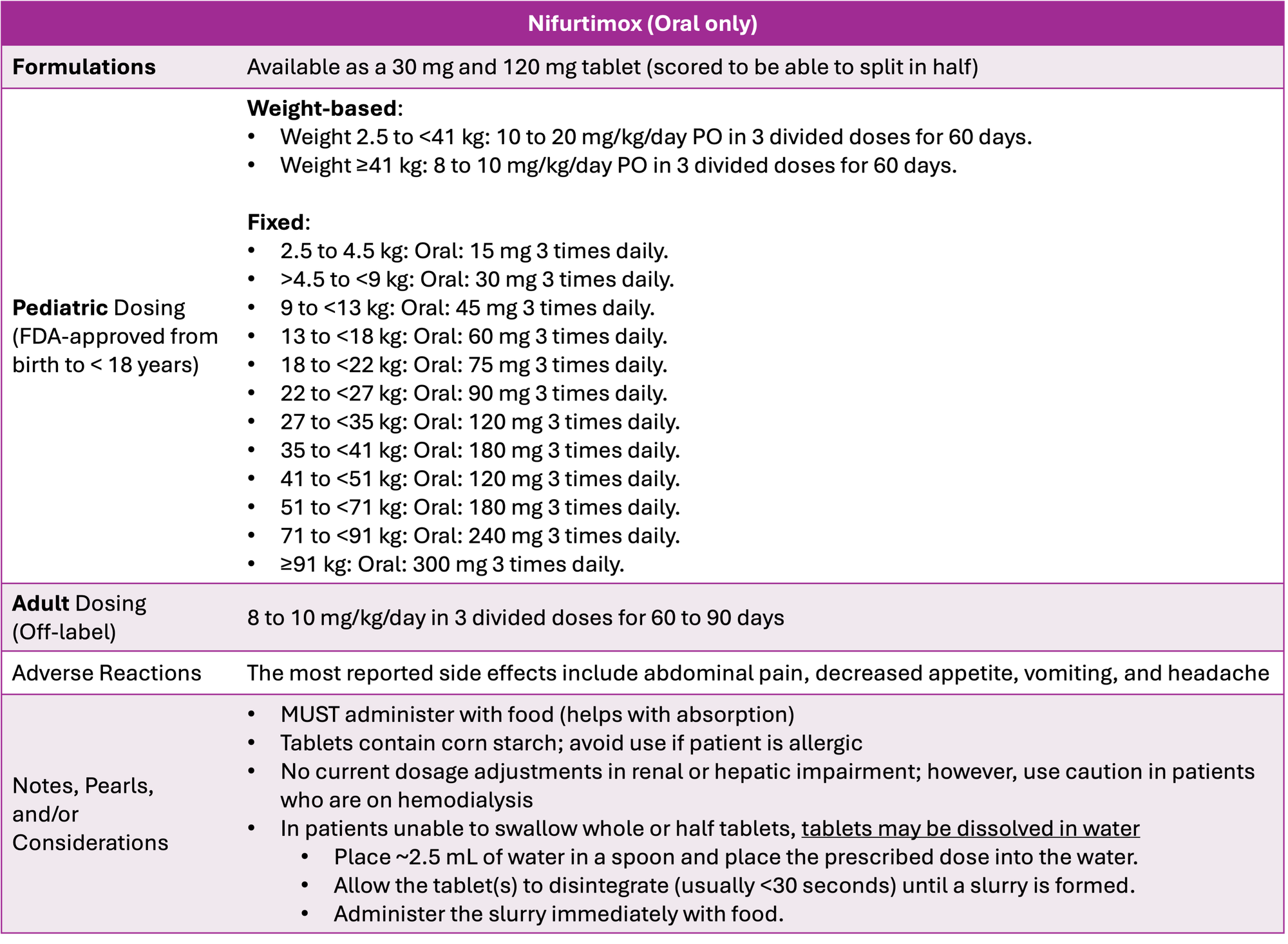
Conclusions
Chagas is no joke of an infection, that we can all agree on. According to the WHO, Chagas leads to more than 10,000 deaths annually! Here is a brief overview of what today's article reviewed:
Have you ever encountered a Chagas case before? Let us know in the comments!
References
- Santanello CD, Santos EM, Mueller HC, Hargraves IR, Rogers AP, Peterson BF. Trypanosoma cruzi (Kinetoplastida: Trypanosomatidae) in the Midwest: prevalence among vectors and medical provider awareness. J Med Entomol. 2025;62(3):667-674. doi:10.1093/jme/tjaf018
- World Health Organization: https://www.who.int/news-room/fact-sheets/detail/chagas-disease-(american-trypanosomiasis)
- Sangenito LS, Branquinha MH, Santos ALS. Funding for Chagas Disease: A 10-Year (2009-2018) Survey. Trop Med Infect Dis. 2020;5(2):88. Published 2020 Jun 1. doi:10.3390/tropicalmed5020088
- Centers for Disease Control: https://www.cdc.gov/chagas/about/index.html
- Texas A&M University Kissing Bug Community Science Program: https://kissingbug.tamu.edu/
- University of Saskatchewan: https://wcvm.usask.ca/learnaboutparasites/parasites/trypanosoma-cruzi.php
- Pan-American Health Organization: https://www.paho.org/en/topics/chagas-disease
- Benznidazole FDA Drug Label: https://www.accessdata.fda.gov/drugsatfda_docs/label/2017/209570lbl.pdf
- Nifurtimox FDA Drug Label: https://www.accessdata.fda.gov/drugsatfda_docs/label/2020/213464s000lbl.pdf
- Lexicomp. (n.d.). Benznidazole: Drug information. UpToDate. Retrieved from https://www-uptodate-com.mwu.idm.oclc.org/contents/benznidazole-drug-information?sectionName=Adult&anchor=F50625938&source=auto_suggest&selectedTitle=1~1—2~4—benznidazole&showDrugLabel=true&search=benznidazole#F50625938
- Lexicomp. (n.d.). Nifurtimox: Drug information. UpToDate. Retrieved from https://www-uptodate-com.mwu.idm.oclc.org/contents/nifurtimox-drug-information?sectionName=Adult&anchor=F53833070&source=auto_suggest&selectedTitle=1~1---2~4---nifurtimox&showDrugLabel=true&search=nifurtimox#F53833070

*Information presented on RxTeach does not represent the opinion of any specific company, organization, or team other than the authors themselves. No patient-provider relationship is created.

